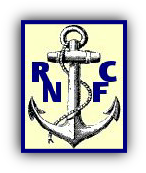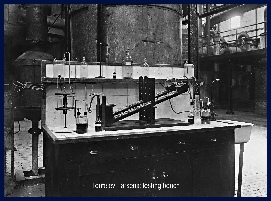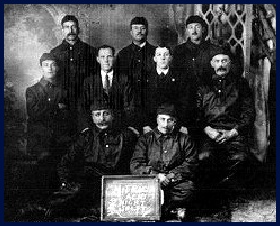
The Story of the
Holton Heath, Dorset, UK

Sulphuric and Nitric Acid
Manufacture and Use
Sulphuric acid was a major factory requirement being used on its own, for the production of nitric acid, which in combination with it, was needed to produce guncotton, nitrocellulose, nitroglycerine and picrite – all materials required in the production of Cordite. At the Royal Naval Cordite Factory sulphuric acid was also used in the production of the high explosive tetryl.
In order to fulfil all these needs an acid factory was established within RNCF to produce the large quantities of both sulphuric and nitric acid needed and also to deal with the waste acid after use.
Sulphuric Acid Production
The raw material used here was iron pyrites, familiarly known as “fool’s gold” with the gold sheen on smooth crystalline pieces of it, which was imported from such places as San Telmo in Spain and from Bjorkassen in Norway. The heavily laden vessels alongside Poole Quay appear to have virtually empty holds as a consequence of the very high density of the pyrites. The cargo was transferred to the factory in railway trucks after the material had been sampled by taking random grabs to be transferred to one special truck. This was examined at the factory and representative samples removed and reduced to manageable amounts by ‘quartering’ with a large metallic plate cross-shaped on a clean floor area. Opposite quarters were further reduced each time until the samples for analysis for factory, supplier and one for the umpire were sealed in bottles.
The price per ton was assessed on the basis of sulphur content. Results from both the Admiralty and the contractor were exchanged on a pre-arranged date and if the two differed by less that 0.5% then the mean of the figures formed the basis of the invoice but if the difference was greater than this a
check sample was then to be sent to an independent firm for analysis. The umpire’s assay was taken as final and binding on both parties.
The sulphuric acid factory had a pyrites store which held 6000 tonnes situated close to the main railway line but, in addition, there was a reserve store at Rocklea where a further 4000 tonnes were held, this total being at least 18 months supply.
Sulphuric acid was produced by the so-called contact process in a
Tentelev plant. The pyrites was burned in the plant at a maximum rate of 20 tonnes per day to give sulphur dioxide gas which is extremely irritating to the eyes, nose and throat. This gas was then drawn, together with air, by rather noisy fans over a platinum catalyst which was used in finely divided form on an asbestos support. The resulting sulphur trioxide gas was dissolved in already concentrated sulphuric acid (95%) to give saturated sulphuric acid or oleum (105%). This was then diluted to give strengths appropriate to the process in which it was to be employed. By 1939 this acid was being produced at the rate of 150 tonnes per week.
During World War II when the pyrites sources were not available a sulphur burner was installed and sulphur from the USA was used as an alternative precursor.
The requirements of a replacement platinum converter plant was called for in 1953 and laboratory staff was called in to weigh out thousands of individual amounts of 18 grams of platinised asbestos to be placed between perforated spacers in the individual converter tubes.
The effect of the platinum catalyst would be very much reduced if it became contaminated with arsenic from the burning process so the gas was

treated to remove it and a check on the efficiency of this was made by sending a small bypass supply through a glass bubbler tube from which a sample was taken daily and analysed in the acids laboratory. Despite the factory doors being left open there were occasional leaks of sulphur dioxide and the person collecting the sample would often avoid being too long in the factory and, when used to the sampling technique, could manage to do it by taking a deep breath before entering the factory and avoid the need for another one till getting outside again.
Nitric Acid Production
Nitric acid was made at the Royal Naval Cordite Factory by the action of heat on a mixture of sulphuric acid, made on site, and sodium nitrate, known commercially as Chile saltpetre, contained in cast iron retorts or stills of which there were twelve installed at Holton Heath. These twelve retorts used about four tonnes of gas coal each when the plant was in full operation. The output of nitric acid was about 100 tonnes per week in 1940.
A by-product of this process was a material called nitre cake and at peak output as much as 150 tonnes per week was produced. This material was used in the manufacture of ‘Harpic’ the well known domestic cleanser. Some 50 tonnes per week was sent to Wilmington near Hull, for the use of Harpic and the rest was dumped. There were some old railway trucks kept specially for this traffic on account of the corrosive nature of this material. Some of these were of London, Brighton and South Coast Railway origin.
During the second world war nitric acid was brought into RNCF from the
Royal Naval Propellant Factory at Caerwent and from ICI Ltd., where it was manufactured from ammonia. The old nitre stills continued to be used to make up any deficiency and the process was an economically attractive way of using old and dirty sulphuric acid.
Acid Recovery Plant
In addition to the manufacture of sulphuric and nitric acids, the factory was also responsible for recovering and rectifying spent acid mixed acids after they had been used. This was an important aspect of the acids factory work and it was therefore equipped with a whole range of plant for these purposes, including de-nitration towers (to remove nitric acid from sulphuric acid), detetrylating plant, Kessler concentrators for sulphuric acid and much else. It is worth noting that Kessler concentrators must have been formidable pieces of equipment, since the accident book records a high number of acid burns received when maintenance was in progress including several occasions when workers fell into the interior!

Acid Workers
The Acids factory formed an administrative unit with the Guncotton factory and the directing staff of this unit consisted of a Chemist-in-charge assisted by a Chemist. The unit was also responsible for the supervision and control of the Tetryl factory and the Picrite factory.
Adjacent to the nitric acid factory there was a large effluent or ‘drainage’ pond. It is understood that it would receive dilute acid or alkaline materials from the process plants in the locality and a check would be made periodically to adjust the pH (acidity or alkalinity) and to add soda ash or dilute acid as necessary before releasing it into the harbour.
In the same area was an underpass of the main railway line allowing a branch of the internal narrow gauge railway to take waste material to a large tip on the northern shore of Poole Harbour.
By John England